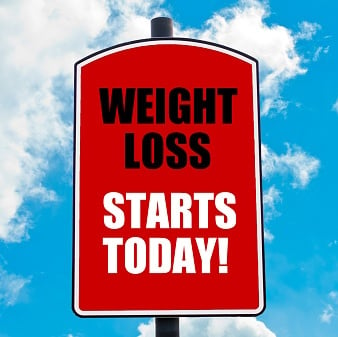Starting your weight loss journey today is the first step towards a healthier, happier you. Commit to positive changes now.
Embarking on a weight loss journey requires determination and a solid plan. Begin by setting realistic goals and tracking your progress. Incorporate a balanced diet rich in fruits, vegetables, lean proteins, and whole grains. Regular exercise is crucial; aim for at least 30 minutes of physical activity most days.
Stay hydrated and get adequate sleep to support your efforts. Surround yourself with supportive friends and family to stay motivated. Remember, consistency is key to success. Celebrate small victories along the way and stay focused on your long-term health goals. Your journey to a healthier lifestyle starts today.
Embarking On A Weight Loss Journey
Starting a weight loss journey is a big step. It requires commitment and a positive mindset. With the right approach, you can achieve your goals and transform your life.
Setting Realistic Goals
Set realistic goals to keep yourself motivated. Break down your ultimate goal into smaller milestones. This makes the journey easier and more achievable.
| Goal Type | Description |
|---|---|
| Short-Term | Lose 1-2 pounds per week |
| Medium-Term | Lose 10 pounds in 3 months |
| Long-Term | Reach a healthy weight in a year |
Use a journal to track your progress. Celebrate each milestone. This will boost your confidence and keep you on track.
Embracing The Mindset For Change
A positive mindset is crucial for success. Believe in your ability to change. Visualize your goals and focus on the benefits of a healthier life.
- Think positively
- Stay motivated
- Visualize your success
Practice daily affirmations. Remind yourself of your strengths and achievements. Surround yourself with supportive people who encourage your journey.

Credit: mangoclinic.com
Nutritional Cornerstones For Weight Loss
Starting your weight loss journey today means focusing on the right nutrition. Understanding what you eat helps you reach your goals faster. Let’s dive into the key nutritional cornerstones for weight loss.
Understanding Macronutrients
Macronutrients are the building blocks of our diet. They are proteins, carbohydrates, and fats. Each one plays a unique role in our body.
| Macronutrient | Role | Examples |
|---|---|---|
| Proteins | Build and repair tissues | Chicken, beans, tofu |
| Carbohydrates | Provide energy | Rice, bread, fruits |
| Fats | Support cell growth | Avocado, nuts, olive oil |
Balancing these macronutrients is key for effective weight loss. Aim to include a mix of proteins, carbs, and fats in every meal.
Importance Of Hydration
Drinking enough water is crucial for weight loss. Water helps your body function properly. It aids digestion, helps you feel full, and keeps your metabolism active.
- Drink at least 8 glasses of water daily.
- Carry a water bottle to stay hydrated.
- Add lemon or mint to water for flavor.
Avoid sugary drinks like soda and juice. They add extra calories and can hinder your progress. Opt for water, herbal teas, or sparkling water instead.
Designing Your Diet Plan
Starting your weight loss journey can feel overwhelming. Creating a well-structured diet plan is crucial. This section will guide you through essential steps to design a diet that works for you. A balanced diet can make a significant difference in achieving your weight loss goals.
Calorie Deficit Explained
A calorie deficit is when you consume fewer calories than your body needs. This forces your body to use stored fat for energy. Here’s how to calculate your calorie needs:
- Determine your Basal Metabolic Rate (BMR): This is the number of calories your body needs at rest.
- Factor in your activity level: Multiply your BMR by an activity factor (e.g., sedentary, lightly active, very active).
- Create a deficit: Subtract 500-1000 calories per day to lose 1-2 pounds per week.
Using a calorie deficit helps you lose weight steadily. It’s essential to avoid extreme calorie cuts to prevent nutrient deficiencies and muscle loss.
Incorporating Whole Foods
Incorporating whole foods into your diet is key for weight loss. Whole foods are unprocessed and nutrient-dense. They include:
- Fruits and vegetables
- Whole grains like oats and quinoa
- Lean proteins such as chicken, fish, and legumes
- Healthy fats like avocados, nuts, and olive oil
Whole foods provide essential vitamins, minerals, and fiber. They keep you full longer and support overall health. Here’s a simple table to guide your daily intake:
| Food Group | Daily Servings |
|---|---|
| Fruits | 2-3 servings |
| Vegetables | 3-5 servings |
| Whole Grains | 3-4 servings |
| Lean Proteins | 2-3 servings |
| Healthy Fats | 2-3 servings |
Following this guide ensures you get a balanced diet. It supports weight loss and boosts your energy levels.
Physical Activity And Exercise
Starting your weight loss journey is an exciting step towards a healthier you. Physical activity and exercise play a crucial role in this transformation. Incorporating the right mix of workouts can accelerate your progress and improve overall well-being.
Creating A Sustainable Routine
Consistency is key in any weight loss journey. A sustainable exercise routine ensures long-term success. Begin by setting realistic goals. Aim for activities that you enjoy.
Start with small steps. Gradually increase your workout intensity. For example, walk for 20 minutes daily. Over time, extend it to 30 minutes. Then, try jogging or cycling.
Here’s a sample weekly routine to get you started:
| Day | Activity | Duration |
|---|---|---|
| Monday | Walking | 30 minutes |
| Tuesday | Strength Training | 20 minutes |
| Wednesday | Cycling | 30 minutes |
| Thursday | Rest | – |
| Friday | Jogging | 25 minutes |
| Saturday | Strength Training | 25 minutes |
| Sunday | Yoga | 20 minutes |
Cardio Vs. Strength Training
Both cardio and strength training are essential for weight loss. Each has unique benefits. Cardio exercises increase your heart rate. They burn calories quickly.
Examples of cardio exercises include:
- Running
- Swimming
- Jumping rope
Strength training builds muscle mass. More muscle means a higher metabolism. This helps in burning calories even at rest.
Examples of strength training exercises include:
- Weight lifting
- Bodyweight exercises like push-ups and squats
- Resistance band workouts
Balance both types of exercises in your routine. You’ll see better results. Aim for at least 150 minutes of moderate cardio weekly. Include strength training twice a week.
Behavioral Changes For Long-term Success
Starting a weight loss journey can be exciting and challenging. Achieving lasting success requires more than just diet and exercise. Adopting new behaviors can make all the difference. Let’s explore some key behavioral changes for long-term success.
Breaking Bad Habits
Bad habits can hinder your progress. Identify and eliminate them. Start by recognizing triggers that cause you to overeat or skip workouts. Replace these habits with healthier alternatives.
- Swap sugary snacks for fruits.
- Choose water over soda.
- Take short walks instead of watching TV.
Consistency is crucial. Track your progress and celebrate small victories. Use a journal or app to monitor your habits. Stay motivated by setting achievable goals.
Cultivating A Support System
A strong support system can boost your success. Surround yourself with positive influences. Friends and family can offer encouragement and accountability.
| Support Type | Examples |
|---|---|
| Emotional Support | Encouragement, listening, motivation |
| Practical Support | Meal prep, workout buddies, sharing recipes |
| Informational Support | Advice, tips, educational resources |
Engage with online communities for additional support. Join forums, social media groups, or local clubs. Sharing experiences and tips can be very helpful.
Tracking Progress And Staying Motivated
Starting a weight loss journey is exciting and challenging. Tracking progress and staying motivated are key to success. This section will guide you on how to monitor your weight and body measurements, set milestones, and reward yourself.
Monitoring Weight And Body Measurements
Regularly checking your weight helps you see your progress. Use a digital scale for accurate readings. Weigh yourself at the same time every day.
Body measurements are also important. Track your waist, hips, and chest sizes. Use a flexible measuring tape for this. Record these measurements weekly.
| Measurement | Frequency |
|---|---|
| Weight | Daily |
| Waist | Weekly |
| Hips | Weekly |
| Chest | Weekly |
Setting Milestones And Rewards
Set small, achievable goals to stay motivated. Break your weight loss goal into smaller milestones. For example, aim to lose 5 pounds first.
Reward yourself for reaching each milestone. Non-food rewards work best. Some ideas include:
- New workout clothes
- A relaxing spa day
- A fun outing with friends
Keep a journal to track your milestones and rewards. This helps you see your progress and stay motivated.
Dealing With Plateaus And Setbacks
Starting a weight loss journey can be exciting, but plateaus and setbacks are inevitable. These moments can feel discouraging, but they are part of the process. Understanding how to navigate these challenges is key to long-term success.
Adjusting Strategies As Needed
Weight loss is not a straight path. You might need to adjust your strategies along the way. If your progress stalls, it might be time to change your exercise routine. Try new activities or increase the intensity of your workouts.
Nutrition also plays a significant role. Re-evaluate your diet. Ensure you are eating a balanced diet rich in nutrients. Sometimes, small changes like reducing portion sizes or cutting out sugary snacks can make a big difference.
| Current Strategy | Possible Adjustments |
|---|---|
| Walking daily | Incorporate jogging or cycling |
| Eating three large meals | Switch to five smaller meals |
| Regular gym workouts | Try a new fitness class |
Maintaining Perspective And Persistence
It’s easy to feel defeated when progress slows. Keeping perspective is crucial. Remember, weight loss is a marathon, not a sprint. Celebrate small victories and focus on the overall journey.
- Track your progress with photos and measurements, not just the scale.
- Reflect on how far you’ve come, not just how far you have to go.
- Stay motivated by setting achievable short-term goals.
Persistence is key. Stay committed to your goals, even during tough times. Setbacks are temporary. Adjust your strategies, maintain perspective, and keep pushing forward. Your weight loss journey is a continuous process of learning and adapting.

Credit: www.facebook.com
Beyond Weight Loss: Maintaining Your New Lifestyle
Embarking on a weight loss journey is a significant achievement. Yet, the real challenge lies in sustaining your new lifestyle. Transitioning from weight loss to maintenance requires adopting new habits. It involves continuous learning and adaptation. Let’s explore how to maintain your new, healthier lifestyle.
Adopting Long-term Healthy Habits
Adopting long-term healthy habits is crucial for maintaining your weight loss. Here are some tips to help:
- Regular Exercise: Incorporate physical activities you enjoy. Aim for at least 30 minutes a day.
- Balanced Diet: Eat a variety of foods. Focus on vegetables, fruits, and lean proteins.
- Stay Hydrated: Drink plenty of water. Limit sugary drinks.
- Adequate Sleep: Aim for 7-8 hours of sleep each night. Rest helps your body recover.
- Mindful Eating: Pay attention to your hunger and fullness cues. Avoid overeating.
Continued Learning And Adaptation
Continued learning and adaptation are key to a sustainable lifestyle. Here are some strategies:
- Stay Informed: Read about nutrition and fitness. Knowledge helps you make better choices.
- Set Realistic Goals: Break your goals into small, manageable steps. Celebrate each achievement.
- Listen to Your Body: Adapt your routine based on how you feel. Your body’s needs can change.
- Seek Support: Join a community or find a buddy. Support keeps you motivated.
- Track Progress: Use a journal or app. Tracking helps you stay on course.
Maintaining your new lifestyle is a lifelong commitment. With dedication and these strategies, you can thrive beyond your weight loss journey.

Credit: timesofindia.indiatimes.com
Frequently Asked Questions
What Is The Start Journey Of Weight Loss?
The start journey of weight loss involves setting realistic goals, creating a balanced diet, and incorporating regular exercise. Track progress and stay motivated.
What Is The Best Day To Start A Weight Loss Journey?
The best day to start a weight loss journey is today. Immediate action boosts motivation and commitment. Start with small, achievable goals to build momentum. Consistency is key for long-term success.
When You Start Losing Weight Where Does It Start?
Weight loss typically starts in areas with less fat, like the face and belly. Each person’s body is different.
What Is The 30 30 30 Rule For Weight Loss?
The 30 30 30 rule for weight loss involves 30 minutes of exercise, 30 grams of protein, and 30 grams of fiber daily. This approach helps boost metabolism, improve digestion, and promote satiety, aiding in effective weight loss.
Conclusion
Embarking on your weight loss journey today sets you on a path to a healthier life. Small changes create significant results over time. Stay committed, celebrate your progress, and remain patient. Every step you take brings you closer to your goal.
Begin today and witness the transformation.


